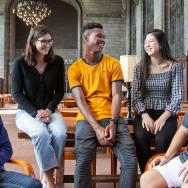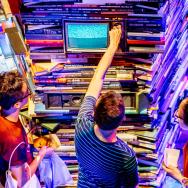As one of their first challenges at the University of Chicago, undergraduate students were given five minutes to tell the world how they planned on saving it.
On stage at the Logan Center for the Arts, first-year Claudia Drozd took the mic. A striking image appeared on the screen behind her—a rendering of tree-like structures dotting the courtyard of Campus North Residential Commons. Facing the panel of faculty judges, Drozd delivered the team’s big idea for addressing climate change.
“We would like to introduce you to ‘the algae tree’ as an addition to the already certified botanical garden of UChicago,” Drozd said.
Inspired by an idea developed in Copenhagen, the team’s project proposed installing tree-shaped, bioluminescent bioreactors that would provide light and food sources on campus. The concept was among the dozens of innovative student ideas to combat climate change—ranging from a low-cost clothing swap program to reduce textile waste to a strain of bioengineered, hyper-efficient carbon sink plants.
“The purpose of the game was to encourage students to think outside the box,” said Drozd, whose Team Ad Astra including Bernadette Miao and Kaylie Scorza won the best speculative design. “By expanding our horizons about how to solve climate change, even beyond the lab, we can come up with ideas that may never have been thought of before.”
The unique Orientation Week event was the culmination of a months-long alternate reality game called Terrarium, an ambitious UChicago faculty-led project to encourage incoming students to work collaboratively, develop a sense of community and learn the kind of rigorous inquiry at the heart of UChicago’s core values.
Set in a post-apocalyptic world in the year 2049, Terrarium provided clues and puzzles via online videos and group chats over the summer to help students develop innovative proposals about climate change.
“We presented different, mostly dystopian visions of the future, and then we invited students to invent their own, constructive visions that they might actually want to work toward,” said Prof. Patrick Jagoda, one of the ARG’s co-creators. “This project isn’t just about immediate outcomes; it’s about demonstrating to students what they can accomplish in just a few days, then thinking about how they can extend such collaborative and imaginative energy across their four years here.”
Making an alternate reality
ARGs use real life as a stage to tell an interactive story. Beginning with a welcome letter sent to all first-years in May, students uncovered the Terrarium narrative scattered across a series of websites and then connected on the streaming platform Twitch to play a live, futuristic game.
Terrarium grew from a project named The Parasite, an ARG that co-directors Jagoda, Heidi Coleman and Kristen Schilt ran during O-Week in 2017. This team sees gaming as an opportunity for students to approach new situations, like entering college, with a sense of community and security.
“It’s about getting students into different zones of perception, attention and motivation,” said Jagoda, professor in the Departments of English and Cinema and Media Studies and director of the Weston Game Lab, a workspace for students to study, create and play games at Crerar Library. “Often, students and faculty are zeroed in on their fields. This project aims to get people thinking outside of those smaller, sometimes more insular, worlds and into a new, interdisciplinary mode.”
Terrarium understands gaming—especially video gaming—to be a form that is particularly resonant in the 21st century. “We’re trying to use a dominant language of 2019 to speak to 2019,” Jagoda said. “Games have significant cultural currency right now— both figuratively and literally. Beyond games, we’re seeing the rise in use of platforms like Twitch for streaming games, and we wanted to see how we could invent new forms on top of that platform.”
What resulted was a series of four interactive worlds, performed and played from July to September. The four worlds depicted different versions of the year 2049, each afflicted by different consequences of climate change—from food shortages and nuclear fallout to social and political turmoil. Performers from across Chicago and the University depicted “Anchors” who contacted the year 2019 through a communication device known as the SPORE. These narratives presented cautionary visions of our future and explored the human consequences of climate change.
Together with creative experts, Coleman developed these episodic performances, which were streamed live from two tiny sets in the Media, Arts, Data and Design Center in Crerar Library and Midway Studios. Coleman drew from her background in new work development to build the narrative.
“One of the things about ARGs is that you have to keep designing bigger than a player's imagination,” said Coleman, senior lecturer in theater and performance studies. “When players had an idea, we had to build from it quickly. A player should feel quite like Alice in Wonderland—falling through a tunnel that keeps getting bigger and bigger.”
Coleman was pleased to see students finding community through Terrarium. “When we’re uncomfortable or vulnerable, we tend to go back to our usual patterns,” she said. “But there were students, most of whom have never met, who were communicating and problem-solving together around the globe.”
Ethan Dintzner, a member of Team Allobiotical, enjoyed the excitement of following the riddles and online chats throughout the summer. “It taught me to think with an open mind when considering solutions to complex problems,” he said. “That works nicely, considering we were charged to find a solution to an extremely complex problem.”
Envisioning the future together
During the summer, ARG players also formed teams to participate in the capstone event during O-Week called the Futures Design Challenge. After arriving on campus, students met with faculty, staff and peer mentors to develop their ideas, learn presentation skills and hone their visions with their teammates.
More than 40 faculty and staff members were involved in this ARG. Schilt, who leads a research team that investigates the results and outcomes of the ARG, said that making faculty accessible to incoming students was one of the team’s main goals.
“Talking to faculty or going to office hours can be really hard,” said Schilt, an associate professor in the Department of Sociology. “As faculty, you notice that students come in with different levels of comfort when talking to you. But students who participated in the Futures Design Challenge will already have a topic to discuss with their professors.”
Schilt sees the ARG as a chance for students to begin O-Week with an established sense of community. “We are really interested to see if those networks are sustained. Part of me thinks that even if it gets students through their first couple of months—having shared a project, and feeling like they’ve successfully made some friends—that's something,” she said. “We’re hoping that the Challenge makes people feel more embedded, and that they have connections across the University with students and with faculty.”
“The Futures Design Challenge offers incoming students an early chance to take part in the courageous inquiry that is central to a UChicago education,” said John W. Boyer, dean of the College. “As students further their studies, they will have many opportunities to work with faculty experts to explore their intellectual curiosities and address the most complex problems of our time.”
A chance for change
Twenty-two teams presented their ideas on Sept. 27 at the Logan Center as part of the final stretch of the Futures Design Challenge. A panel of faculty and staff members from across the University judged the event and granted a series of awards. In addition to cash prizes, winners earned the opportunity to work with the Polsky Center for Entrepreneurship and Innovation to develop their ideas:
- Smarty Pants Award: Team Ouroboros, for a project that conceived a cycle for sanitizing and reusing fast-food takeout containers between restaurants and customers.
- MADD Scientist Award for best speculative design: Team Ad Astra, for their proposal to install bioluminescent algae trees on campus.
- Most Likely to Go Viral Award: Team Nudged!, for an app to motivate a reduction in household electricity consumption, inspired by UChicago Nobel laureate Richard Thaler’s idea of the “nudge.”
- Hail Mary Award: Team Allobiotical, for their vision of genetically augmented chloroplasts that could turn plants into hyper-efficient carbon sinks.
“I’ve always thought about little ways to affect environmental issues; it’s one of my passions,” said Aurora Zemborain of Team Allobiotical. “The Futures Design Challenge gave my group a platform to develop our ideas into feasible products. It’s rare to have the opportunity to present in front of experts of various fields. It may have been a bit nerve-wracking, but it was incredible.”
“As an aspiring environmental scientist, it was really cool to be given an opportunity to dream big,” said Kaylie Scorza, a member of Team Ad Astra. “We were able to interact with cutting-edge research, concepts and models that are leading the field. I definitely feel more well-rounded after the experience, both as a scientist and individual.”

